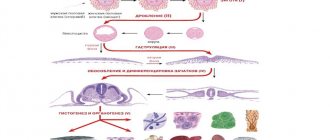During the period of bearing a child, a woman should take care not only of herself, but also of the health of the unborn baby.
95% of expectant mothers are faced with such an unpleasant disease as thrush. The situation is complicated by the fact that in the first trimester many medications are contraindicated and can cause harm, and traditional medicine is ineffective.
Today we will try to understand what thrush is and what measures are necessary to eliminate this type of disease.
What is thrush?
Thrush is scientifically called Candida.
Candidiasis is an infectious disease that occurs due to the overgrowth of Candida fungi. This type of fungi exists in the body of every person. While their quantity is moderate, they do not cause discomfort, but, on the contrary, help the normal functioning of the mucous membrane. With a decrease in the immune system or other factors, an increase in microorganisms occurs, which leads to the appearance of thrush.
According to statistics, 95% of expectant mothers experience this disease. It manifests itself both in the early stages and throughout 9 months of pregnancy, and often more than once.
Completely getting rid of the infection during pregnancy, especially in the first trimester, is problematic, since most drugs are contraindicated. A stressful situation, hypothermia, overeating sweets can trigger the reappearance of Candidiasis.
Why does the risk of thrush increase in the early stages?
According to statistics, vaginal candidiasis is diagnosed in 75% of women at least once throughout their lives. Among pregnant women, thrush is detected 2-3 times more often.
The disease is prone to relapse, so treatment should be systematic.
Unfortunately, many women stop taking prescribed medications after the characteristic symptoms disappear. As a result, thrush takes a chronic form, when symptoms appear periodically.
In the first trimester of pregnancy, the risk of candidiasis increases significantly. The cause of the disease is:
- exacerbation of an untreated chronic form;
- hormonal imbalance accompanied by changes in vaginal pH;
- diabetes;
- decreased immunity;
- seasonal allergies.
Often, before pregnancy, a woman is a carrier of the causative agent of the disease, but the fungus “sleeps”.
Reduced immune defense and hormonal imbalance lead to the creation of optimal conditions for the development of the microorganism.
In addition, due to insufficient natural protection, a woman becomes especially susceptible to any infection, including candidiasis.
Infection can occur from a partner who is also a carrier of the fungus, but is not aware of it, since the microorganism is not in an active form.
Treatment for thrush must be carried out simultaneously with your sexual partner.
Otherwise, after some time the disease will return, and treatment will have to start from scratch.
Sometimes weakened immunity leads to infectious processes associated with the penetration of ureaplasmas or mycoplasmas. In this case, the microflora in the vaginal area is disrupted, which provokes the rapid proliferation of Candida fungus.
Factors influencing the appearance of thrush
During pregnancy, the acidity of the vaginal mucosa decreases, and this is considered a favorable environment for the proliferation of microorganisms of this group.
Factors contributing to the appearance of candidiasis:
- Weakened immunity during pregnancy.
- Hormonal changes in the body.
- Stressful situations and psycho-emotional state.
- Eating large amounts of sweet, salty, citrus fruits.
- Hypothermia of the body.
- Toxicosis, disruption of the gastrointestinal tract.
- Use of hormonal drugs.
It is also worth noting that thrush occurs with increased frequent hygiene procedures, when all the necessary microorganisms are washed away from the mucous membrane.
Is thrush during pregnancy normal?
Usually, the news about her candidiasis shocks the expectant mother. Most women are trying to find an answer to the question: why did this trouble happen to her at such an important moment for her and the baby. However, gynecologists and experienced mothers know that thrush in pregnant women is the most common occurrence.
As you know, the causative agent of thrush (or candidiasis) is a yeast fungus with the luxurious name “Candida”. This microorganism is called opportunistic. Similar mushrooms are also found in the body of a healthy woman, but their quantity is negligible and does not lead to disease. In the body of a woman “in an interesting position” there are factors that contribute to the active reproduction of this microorganism and the displacement of the beneficial microflora of the vagina.
First of all, this is due to natural changes in the body of a pregnant woman, the main ones of which are decreased immunity and hormonal changes.
A decrease in immunity during pregnancy (immune depression) is a natural process, otherwise the mother’s body would perceive the embryo as a foreign object and destroy it.
Hormonal changes are also completely natural during pregnancy. An increase in the amount of estrogen and progesterone in a pregnant woman’s body leads to an increase in vaginal acidity.
As a result, a combination of factors of low immunity and hormonal shifts serve as a “push mechanism” for the appearance of candidiasis during pregnancy.
- consequences of the passage of Candida microorganisms from a woman’s intestines (with dysbiosis of the digestive system);
- due to vaginal dysbiosis existing before pregnancy;
- infection during sexual intercourse from a partner (in 20% of cases);
- a woman eating sweets and flour dishes in excessive quantities;
- treatment with hormones or antibiotics, taking contraceptives or immunosuppressants;
- increased levels of female hormones;
- inflammatory diseases of the genitourinary area;
- some chronic endocrine pathologies (diabetes, obesity, thyroid diseases);
- protracted chronic illnesses (heart disease, chronic anemia, hepatitis, tuberculosis, cancer, etc.);
- vitamin deficiency;
- mechanical microtraumas and hygienic violations (dirt from hands or underwear, friction of tight underwear, rough sex, etc.);
- HIV infection;
- stressful situations;
- poor living conditions (high humidity and poor ventilation, inability to perform feminine intimate hygiene at a normal level).
Usually several of the above factors lead to the disease.
Thrush occurs especially often in the last trimester. The risk of candidiasis is also high in women who already had this disease before pregnancy.
Candidiasis can affect various organs of a woman, but the most common is vulvovaginal candidiasis. This is what the common people call thrush. With this disease, the fungus affects the external genitalia (vulva and vagina) of the expectant mother.
In order to avoid encountering thrush during pregnancy, it is important for a woman and her partner to undergo a full medical examination at the time of pregnancy planning. And if the suspicion of candidiasis is confirmed, both partners need to undergo treatment, and until it ends, protect themselves from pregnancy.
Symptoms
The first manifestations of thrush are almost invisible - the itching is mild, there is a small amount of discharge and, when using panty liners, it is difficult to notice them. Subsequently, the disease begins to progress - the itching becomes severe, causes discomfort, and a burning sensation occurs when urinating. Curd discharge becomes abundant with an unpleasant sour odor. Therefore, at the initial stage of the disease, candida fungi can only be detected by bacterial culture.
Thrush is characterized by a number of symptoms:
- The occurrence of severe itching and burning in the vagina.
- Redness and inflammation of the external genitalia.
- The appearance of white curd discharge.
- Characteristic sour smell.
It is worth noting that such symptoms appear complexly, and not individually.
How to recognize thrush in a pregnant woman?
Candidiasis is caused by yeast fungi belonging to the genus Candida.
There are about 200 species of such microorganisms, but only a few of them are of clinical importance and can cause symptoms of thrush. The most common causative agent of genital candidiasis during pregnancy is Candida albicans, which is detected in smears in almost all patients. Fungal microorganisms can cause damage to mucous membranes, skin, nail plates, eyes and internal organs. The chronic form of thrush can lead to allergization of the body with the occurrence of urticaria, itching of the skin, redness and swelling of the eyelids. The most common variant in pregnant women is vulvovaginal candidiasis.
The main causes of candidiasis include:
- Physiological weakening of the immune system during pregnancy.
- A decrease in the acidity of the environment in the vagina, associated with changes in hormonal levels.
- Increased proliferation of candida fungi in diabetes mellitus and pregnancy diabetes.
- Violation of the rules of intimate hygiene (frequent wearing of synthetic underwear, irrational use of sanitary pads, rarely changing tampons, incorrect selection of detergents and use of regular soap).
- Excessive “passion” for personal hygiene. Frequent washing with disinfectants, douching, which leads to washing out the natural flora of the vagina and the development of dysbiosis.
- The use of spermicides for the purpose of contraception and protection against STIs.
- Taking antibacterial drugs, corticosteroids and cytostatics.
- Hypothermia, prolonged wearing of wet underwear after swimming in open water or swimming pools.
If candidiasis occurs during pregnancy, it is important not to engage in self-diagnosis and self-medication, but to consult a gynecologist who will determine the cause of the fungal disease and prescribe appropriate effective comprehensive treatment.
Candidiasis that occurs during pregnancy is manifested by pronounced clinical symptoms.
The most common symptoms of thrush are:
- Itching, burning sensation in the vagina, perineum, labia majora and labia minora. The intensity of this symptom can vary from mild to intense, up to the occurrence of insomnia and irritability in the patient.
- The appearance of abundant cheesy discharge from the genital tract.
- Discomfort, burning during urination, slight cloudiness of urine.
- Hyperemia and swelling of the labia, perineum, and anal area.
- Feeling of burning, fullness, pain during sexual intercourse.
- Increase in body temperature to 37 degrees, deterioration in general health, weakness, headaches.
In the initial stages and in case of careful adherence to the rules of personal hygiene, the symptoms of thrush can be mild and practically do not bother the woman. That is why it is important to undergo preventive medical examinations at the planning stage and during pregnancy, since untreated candidiasis can lead to complications, disruption of the course of pregnancy and damage to the fetus.
In order to diagnose candidiasis during pregnancy, the specialist carefully collects the patient’s complaints and medical history, and also conducts a gynecological examination. The following additional laboratory methods are used:
- Vaginal smear followed by microscopy. Normally, the main part of the vagina consists of Dederlein's rods, a small number of red and white blood cells, as well as single fungal cells. If numerous fungal microorganisms, spores and candida mycelium are detected, a diagnosis of thrush is made.
- PCR is a modern diagnostic method that allows you to diagnose even single DNA of the pathogen in the body. This method is very sensitive, but is rarely used for thrush due to its high cost.
- The cultural method consists of inoculating the resulting smear on a specialized Sabouraud nutrient medium and assessing the grown colonies a few days later.
The bacteriological method is the most important for diagnosing thrush during pregnancy, since it can be used to determine the sensitivity of pathogenic microorganisms to antifungal drugs and select the most effective course of treatment.
The disease appears for the following reasons:
- wearing synthetic underwear;
- vaginal injuries that can occur as a result of rough sexual intercourse;
- unprotected sexual intercourse;
- decreased immunity after suffering serious illnesses (tuberculosis, diabetes, hypothyroidism);
- long-term use of antibiotics, they kill all beneficial microorganisms that can fight the fungus;
- lack of vitamins;
- diseases of the reproductive or urinary systems;
- gastrointestinal diseases;
- excessive consumption of sweet foods (sugar is “food” for yeast bacteria).
The above reasons may occur, but the main reason why a woman may develop thrush during pregnancy in any trimester is changes in the vaginal microflora. They are caused by an increase in the amount of estrogen and progesterone, which provokes the growth of harmful fungi.
Symptoms of candidiasis are:
- itching or burning sensations in the female genital area;
- vaginal discharge is white or yellowish in color, characterized by a cheesy consistency. Often have a sour or fishy odor;
- pain during urination or sexual intercourse.
It is worth knowing that the above symptoms are characteristic not only of candidiasis, therefore every woman who discovers at least one symptom in the 1st, 2nd or 3rd trimester of pregnancy should contact a gynecologist to clarify the diagnosis and prescribe treatment. Also, thrush in pregnant women requires mandatory testing.
Thrush during pregnancy
You can often read on websites that thrush is very harmful to the unborn fetus in any trimester when infection occurs. However, the answer to the question of whether thrush is dangerous during pregnancy, according to recent medical research, is negative. The main disadvantage that characterizes thrush during pregnancy and which needs to be treated is discomfort for the mother, but this does not affect the fetus.
Another question that is often discussed among doctors and pregnant girls is whether it is possible to get pregnant with thrush? To understand this issue, it is worth considering the features of the course of the disease. The female reproductive system functions based on the normal ratio of acids and alkalis in the vagina.
When a woman develops thrush during pregnancy, regardless of trimester, the balance is disrupted. If a woman is healthy, then up to 90% of lactic acid bacteria live in her vagina, which are characterized by the production of lactic acid and other substances that are a shield against various diseases.
After the microflora is disturbed (thrush is detected), yeast fungi begin to multiply there, as a result of which the acidity of the vagina decreases. In this case, sperm are less likely to survive, but a girl can still get pregnant with thrush.
Despite the fact that, in principle, it is possible to become pregnant if thrush develops, this disease should still be treated. If a woman wants to become pregnant, she needs to immediately go to a qualified doctor when symptoms of the disease appear, have tests done and treatment of the pathology.
A woman can be cured of thrush during pregnancy in any trimester of pregnancy if she goes to the doctor and undergoes a thorough diagnosis. It provides:
- bacterioscopy - taking a smear to study the vaginal microflora. It is taken by the gynecologist during the examination using a disposable spatula. The method of taking a smear is absolutely painless and quick. A smear from the vagina, urethra, and cervix is sent for laboratory testing, and the result obtained is sufficiently informative for making a diagnosis and prescribing treatment;
- If the smear does not reveal signs of the disease, but the symptoms of candidiasis are “obvious,” then specialists use a cultural technique to determine the fungus. The material obtained during a smear is added to a medium that promotes fungal growth;
- PCR method. It is the most expensive method due to its sensitivity, but is rarely used in diagnosis due to false results.
We suggest you familiarize yourself with How to treat baby oral thrush
Diagnosis of thrush during pregnancy
The symptoms of candidiasis in expectant mothers differ little from the manifestation of this pathology in non-pregnant women. And if a woman has suffered from thrush before, then she will not discover anything new for herself during this disease during pregnancy.
The most typical manifestations of candidiasis in pregnant women are the following symptoms:
- redness and swelling of the external genitalia;
- whitish, cheesy discharge (flakes) from the vagina with a sour odor;
- itching and burning in the genitals, increasing with urination or after sexual intercourse;
- manifestations of candidal urethritis in the form of pain and burning when urinating or discharge from the urethra.
https://www.youtube.com/watch?v=KBGkSBPAJJg
Summarized, all of the above symptoms significantly complicate the life of a pregnant woman.
Often in pregnant women, thrush occurs in an erased form and becomes chronic.
Hygiene measures can temporarily stop the symptoms of itching and pain. In some cases, candidiasis accompanies other sexually transmitted infections that are more dangerous for the fetus.
Common diagnostic methods for thrush are:
- collecting anamnesis about data regarding the woman’s illnesses before pregnancy;
- information about medication treatment;
- general and gynecological examination;
- blood tests (general and biochemical);
- chest x-ray;
- examination by narrow specialists.
How can it be dangerous?
Most women don't even know how dangerous thrush is. Thrush is a harmless disease that poses a threat to the mother and the unborn baby.
Threat to mother
Negligence towards candida disease entails the following consequences:
- Severe itching and irritation cause discomfort, cause insomnia, as a result of which blood pressure rises and tone increases. This can lead to placental abruption and the threat of premature birth, and even termination of pregnancy.
- The elasticity of the genital organs decreases, which accelerates the development of cervical erosion. During labor, this leads to numerous ruptures, which subsequently heal poorly.
- Possible infection of the urethra and bladder.
- Against the background of candidiasis, the risk of other infectious diseases increases.
- Violation of the reproductive function of women.
Threat to baby
For the baby, thrush also poses a danger; in addition to infection, you need to understand how to properly treat the mother so as not to harm the fetus.
- The likelihood of infection of the fetus with other infections that develop against the background of candidiasis. Infection occurs through the placenta, or during the passage of the baby through the birth canal.
- Possible infection of the fetus with a fungal infection of Candida, which can lead to the death of both the fetus and the born child. This is extremely dangerous for premature babies.
- Premature birth or intrauterine growth retardation, the possibility of missed abortion.
Symptoms in early pregnancy
Currently, more than 200 species of Candida fungi are known. There is no need to specify whether it belongs to one species or another, but for information, it should be borne in mind that the nature of the discharge from the genital tract may vary: from cheesy to creamy mucous. More often, the discharge is cheesy in nature (in 95% of cases).
A feature of thrush during pregnancy, in contrast to gynecological patients, is the absence of complaints in the presence of discharge:
- When examining the mucous membrane of the vaginal opening, vagina, cervix, external urethral opening, pastiness, friability and swelling are determined.
- The color of the mucous membrane changes from pale pink to red-bluish.
- There is a cheesy discharge on the walls of the vagina and inside it, sometimes in significant quantities (up to half a glass or more).
- When a secondary banal or specific infection occurs, the color of the discharge may change to yellowish-green. This creates an unpleasant sour smell.
Only a small number of pregnant women in the early stages may have “classic” symptoms of thrush:
- Burning, itching in the vagina, which is sometimes unbearable. The burning sensation often intensifies when washing, after sexual intercourse, in the evening and at night.
- Discomfort and burning when urinating.
- Dyspareunia (painful sexual intercourse).
- Irritability, insomnia, nervousness.
- Characteristic cheesy discharge.
Ongoing research:
- To confirm the diagnosis, a laboratory diagnosis of a smear taken during examination of the pregnant woman is sufficient. During microscopy, the laboratory assistant finds mycelium and threads of the fungus.
- Cultural diagnostics (culture on media) is carried out in case of long-term unsuccessful treatment.
- Immunological methods are extremely rarely used to detect antibodies to Candida fungi and its species.
- The PCR polymerase chain reaction method has also not been widely used for diagnosing Candida yeast because of the large number of false positive results.
The disease can last a long time. The duration of thrush up to 2 months is considered an acute process, beyond this time it is considered chronic. Chronic thrush can recur.
Why is it dangerous?
You say: “Such a nice, kind name, especially since the fungi are our own, not strangers, there are practically no complaints. What is there to treat?” And you will be completely wrong! Although seemingly harmless, thrush poses a serious danger to the expectant mother and child at all stages of pregnancy and the postpartum period:
- In the early stages, against the background of thrush, early gestosis is more common. Their course is more severe and prolonged than during the normal course of pregnancy.
- A dangerous complication that threatens pregnancy loss, early and other miscarriage.
- When asked whether a child born from a sick mother can have thrush, unfortunately, doctors give a positive answer. Thus, in utero, a baby can get congenital candidiasis, which often causes stillbirths and death of the child after childbirth. In 30% of all perinatal deaths, the child had signs of thrush. Thrush penetrates all organs and tissues; there may be candidiasis of the intestines and pneumonia.
- In turn, acquired candidiasis in an infant occurs due to contact of the child’s skin with the mother’s infected genitals. Yeast stomatitis is common, and candidiasis dermatitis is also possible.
- The frequency of late gestosis, pathology of the placenta, abruption of the normally attached placenta and anomalies of its attachment is increasing.
- During childbirth, labor anomalies, untimely rupture of water, increased maternal trauma, and bleeding in the postpartum and early postpartum period are possible.
- Also, after childbirth, there is a high probability of developing purulent-septic complications.
In some cases, when thrush is not severe, if the woman refuses treatment, the pregnancy ends with a normal birth and on time. Moreover, the mother can please her loved ones with a healthy baby.
Children from mothers with thrush are often born in a state of chronic hypoxia and with low weight.
Diagnostic methods
Although candida infection is a common condition in expectant mothers, diagnosis and treatment are very important.
- When examined in a chair, the attending physician determines the consistency of the discharge, its abundance and the presence of an inflammatory process.
- A smear will help identify elevated levels of white blood cells and detect fungal spores.
- Bacteriological culture provides an accurate diagnosis. It allows you to detect candidiasis at an early stage of the disease. The disadvantage of this type of analysis is the duration of its implementation.
Treatment with folk remedies
Thrush in early pregnancy is characterized by severe itching, tissue swelling, burning and redness. Taken together, these symptoms cause severe discomfort and cause a decrease in the quality of life in general. To eliminate these symptoms, increase the body’s immune forces and its resistance, it is recommended to use remedies prepared at home according to alternative medicine recipes. They can be used, among other things, along with taking medications.
Therapeutic baths
To eliminate itching and burning, as well as normalize the vaginal microflora, it is recommended to use medicinal baths based on medicinal solutions prepared independently. This treatment method does not affect the development of the fetus and eliminates discomfort. Particularly popular recipes for preparing bath solutions include:
- Camomile tea. The infusion has soothing, antiseptic and anti-inflammatory properties and has virtually no contraindications for use. To prepare it, you should steam three tablespoons of dried inflorescences with a glass of boiling water, leave for at least an hour and dissolve in two to three liters of warm water.
- Herbal collection. A solution prepared on the basis of a multicomponent herbal collection has no less effective properties. To begin, mix equal amounts of chamomile and calendula inflorescences, sage, yarrow and juniper herbs, as well as eucalyptus leaves. Next, steam three tablespoons of the raw material with a glass of boiling water and use it by analogy with the previous recipe.
- Iodine and soda. Baking soda, which promotes an alkaline environment, is a particularly effective and frequently used remedy for candidiasis. To prepare a therapeutic bath, it is enough to dissolve six to seven drops of iodine and two tablespoons of soda in two liters of warm water.
- Soda and salt. A solution of sea salt and soda also has antifungal properties. To prepare such a bath, just dissolve one spoonful of salt and soda in a warm liquid. It is not recommended to use salt that contains flavorings or dyes.
For thrush, medicinal baths should be used daily for ten to fifteen minutes. After completing the procedure, you should not wash off the healing liquid; just wipe the genitals with a dry towel.
Douching
Candidiasis can also be eliminated in the early stages of pregnancy through the use of douches. The main advantages of this type of procedure are ease of use and a large area of providing a therapeutic effect. For douching, you can use the following solution options:
Methods to combat thrush
During pregnancy, drug therapy should be treated with great caution. In the first trimester, all vital organs are formed in the fetus. Many drugs used to treat infection are contraindicated in pregnant women, especially in the early stages.
If you detect any symptoms, do not draw premature conclusions and do not prescribe treatment for yourself.
Only a gynecologist can make a correct diagnosis and schedule treatment after examination and receipt of test results.
Do not self-medicate. This could harm you and your unborn baby, or miss the possibility of a serious illness.
In addition, both expectant parents must undergo a course of therapy.
Drug treatment
Among the drugs, antifungal agents have proven themselves well: Nystatin, Pimafucin, Zalaine, and Clotrimazole.
The drugs Nystatin, Pimafucin, Zalaine are considered non-toxic and absolutely harmless during pregnancy and are prescribed even to newborns. The only drawback is the duration of treatment.
Clotrimazole is effective in advanced cases, but has many side effects. Use in the first half of pregnancy is not recommended.
Levorin, Diflucan, Nizoral, Fluconazole, Lucanazole are strictly contraindicated during pregnancy. They can cause irreparable harm to the mother and unborn baby.
Folk remedies
In the arsenal of traditional medicine, there are many options for curing thrush. These include baths with the addition of tinctures of chamomile, nettle, and calendula, which are anti-inflammatory. And washing with antiseptic solutions of iodine and soda. But it is worth noting that these methods are not very effective and give only temporary results, and can lead to complications of the disease.
Douching is strictly contraindicated for expectant mothers, as it can provoke premature termination of pregnancy.
Folk remedies can be used only in combination with drug treatment, and only after the recommendation of a doctor.
Features of the course of thrush during pregnancy
During pregnancy, a woman's body undergoes serious hormonal changes associated with the formation and development of the fetus. Since the fetal DNA is half foreign to the mother, to prevent its rejection, a physiological decrease in immunity occurs. In addition, high levels of the female sex hormone (estrogen) can provoke disturbances in carbohydrate metabolism in the cells of the mucous membranes, which leads to increased glucose levels and increased proliferation of fungi.
Often, the development of vulvovaginal candidiasis during pregnancy is associated with the activation of a chronic, previously untreated infection. Thrush can also occur after antibiotic therapy (even before conception) for the treatment of other inflammatory diseases of the genital tract (chlamydia, trichomoniasis). This variant of the disease is characterized by scant symptoms and often goes unnoticed, which provokes the development of serious complications:
- Chronic candidiasis can lead to cervical erosion, which increases the risk of cervical rupture during childbirth.
- With prolonged, low-grade inflammation, adhesions often form, which causes abdominal pain, pathologies in the development of the placenta, disorders of the current pregnancy and infertility in the future.
- A decrease in the elasticity of the walls of the birth canal can lead to ruptures during labor.
- Thrush often causes miscarriages and premature births.
- The inflammatory process caused by Candida fungi contributes to slow healing of postoperative sutures and a longer recovery period after childbirth.
Severe infection of the birth canal can lead to doctors refusing to perform natural childbirth in women. In this case, a caesarean section is prescribed as planned. Regular visits to the gynecologist and preventive examinations will help to avoid such consequences.
Ignoring symptoms or self-medicating thrush during pregnancy can create problems not only for the mother’s health, but also harm the baby.
Candidiasis is dangerous for the fetus at any stage of gestation:
- In the first trimester, the formation of the placenta and internal organs of the fetus is disrupted.
- From the 38th week, immediately before birth, fungi can penetrate through the dilated cervix and provoke the formation of fetal IUI.
- As the baby passes through the birth canal, infection can affect his sensitive skin and mucous membranes.
A child with IUI, born from a mother with thrush, has low weight, candidal stomatitis and gastrointestinal lesions, inflammation of the brain and its membranes, an erythematous rash, and specific nodules on the skin and internal organs containing a fungal infection.
We suggest you familiarize yourself with Pimples on the butt, causes in women, treatment
Thrush, accompanied by a delay, is a likely sign of pregnancy, which is observed in 30% of women. The occurrence and intensification of unpleasant symptoms of candidiasis is associated with hormonal changes in the mother’s body:
- An increase in the level of progesterone, noted from the first days of conception until the formation of the placenta, contributes not only to the consolidation of the embryo in the uterine cavity and the characteristic mood swings in a pregnant woman, but also to a change in the acidity and thickness of the vaginal secretion, which promotes the proliferation of fungal microorganisms.
- An increased level of estrogen secreted by the adrenal glands during pregnancy also leads to dysbiosis in the mucous membranes of the genital tract and the occurrence of candidal inflammation.
- The main marker of pregnancy, human chorionic gonadotropin, leads to activation of the thyroid gland, the hormones of which contribute to thrush.
If candidiasis appears against the background of a delay, especially if it is accompanied by other possible symptoms of pregnancy (perversion of taste preferences, changes in sexual desire, nagging pain in the lower abdomen and perineum, sensitivity and swelling of the mammary glands, bloating, nausea, heightened sense of smell) you should buy go to the pharmacy for a special test and get tested for hCG.
In the event of genital candidiasis, it is important to complete a full course of comprehensive, safe and effective therapy as early as possible in order to avoid complications in the woman and fetus.
- So, in the first trimester it is better to treat with completely safe and effective Pimafucin. All existing forms of release are suitable, but the prescription is made by a doctor.
Usually they use vaginal suppositories (the average price in pharmacies is 600 rubles), one at night for 6 days, externally - cream (240 rubles).
When diagnosed with “intestinal candidiasis” in pregnant women, Pimafucin tablets are included in the regimen (450 rubles). Purpose: one per day per oz in a course of 4 days.
- Good recommendations for treatment in pregnant women received: Hexicon vaginal tablets (package No. 10 - 280 rubles);
- candles and Depantol cream (540 and 250 rubles, respectively).
They are prescribed according to the following scheme: 1 suppository twice a day for 7-10 days, extending the course in consultation with the doctor.
Many expectant mothers are afraid of taking medications and they are looking for ways to treat them, using local ones, including those popular in traditional medicine. However, pregnant women (especially in the first trimester) are better off choosing pharmacopoeial drugs that provide relatively quick and guaranteed results, with minimal side effects.
This category includes: vaginal tablets and suppositories, creams and ointments. These forms of drugs are most preferred. Although they are characterized not only by positive, but also by negative aspects.
Arguments in favor of treatment with the listed means are as follows:
- local impact on foci of infection minimizes the negative impact on the general condition of the woman and, most importantly, on the fetus;
- relatively short course (minimum 3 days, maximum 2 weeks);
- effectiveness (unpleasant symptoms cease to bother you after the second or third use);
- preventive effect.
Among the disadvantages, two nuances are usually distinguished:
- inconvenience of intravaginal administration during late pregnancy;
- psychological and physical discomfort arising from the leakage of a candle or, say, cream.
According to doctors, without these “troubles” it will not be possible to quickly stop the symptoms of thrush and cure the fungus when carrying a child.
- A remarkable effect is achieved by local application (hygienic wiping of affected areas with tampons) of the intimate hygiene product Lactacid Femeli. It is only important to choose a composition that provides an acidity level of pH = 3.5.
- Vagisan medicinal gel has proven itself well.
These products, thanks to lactic acid, allow you to optimally level and maintain the normal pH level of the intimate area, eliminating the development of parasitic mycoflora.
The entire period of treatment for thrush in a pregnant woman should be accompanied by the intake of eubiotics - combined or monoculture concentrates of apathogenic microorganisms and bacteria. The classics on this list: Laktovit-Forte, Linex, Vagilak, Lacidofil, Bifidum Bakterin, Lactobacterin.
- In the second and third trimesters, antimycotics Polizhinax or Terzhinan are recommended. Gynecologists explain the choice by considerations of safety, affordability and effectiveness.
Polygynax – vaginal capsules. Standard therapy involves administration every night for 12 days.
Terzhinan – vaginal tablets. They are prescribed to pregnant women after 22 weeks. The entire course requires one package No. 10, administer 1 piece in the evening. For a faster and more complete effect, it is recommended to hold the tablet in water for half a minute before administration.
Additionally, if oral administration of systemic medications is necessary, a leading gynecologist is consulted. The decision is made on the basis of PCR diagnostics, the results of recommended tests, and an analysis of the patient’s general physical condition.
In the chronic form of candidiasis in pregnant women, almost all organs whose tissues have mucous membranes can be affected. In addition to the vagina, the habitats of pathogenic colonies can be: the digestive system, lung tissue, bile ducts, eyelids. Less common: lymphatic ducts, areas of skin around foci of fungal localization.
The ban on taking pills and the desire to save money are often reasons for experimentation. “Proven” methods: douching, insertion of tampons soaked in herbal decoctions or pharmacological solutions, baths. Only the results of home treatment are absent at best, and downright deplorable at worst.
Doctors warn: self-douching and tamponade are prohibited for pregnant women. The first danger is injury. An awkward movement with the tip of the bulb can damage the vaginal walls.
Solutions with “miracle” soda, potassium permanganate, iodine, which our mothers and grandmothers used, when ingested, destroy the local flora, without separating bacteria into harmful and beneficial. They can also cause allergic reactions and dry out the mucous membranes.
Gynecologists are less categorical about baths and washing. For these procedures, herbal decoctions that have an antiseptic and anti-inflammatory effect are recommended. It is allowed to use chamomile, calendula, oak bark, sage, and thyme. An important nuance: the water should not be hot, not cold, but warm.
- whitish discharge with a sour odor;
- itching and burning in the groin;
- hyperemia of the skin of the labia majora and mucous membrane.
- carriage: in this case, a high content of Candida is detected on the patient’s mucous membranes. This condition, with the onset of favorable conditions, can develop into an acute form of thrush; moreover, fungi can harm the fetus during its movement along the birth canal. In this case, a pregnant woman has practically no symptoms, and pathology is detected only as a result of taking a smear or culture;
- acute form. Symptoms of candidiasis are already becoming pronounced: thick discharge, curdled in appearance, white or slightly yellowish in color, as well as itching;
- chronic form: incompletely cured acute candidiasis becomes a “chronicle” with long-term remissions and periodic relapses.
Prevention
It is impossible to give a one hundred percent guarantee that thrush will not occur, but following simple rules will help reduce the risk of the disease.
- Plan to conceive after a complete examination of both spouses.
- Balance your diet. To maintain immunity and normalize the gastrointestinal tract, include more fruits, vegetables and herbs in your diet. Eat foods containing fiber, as well as cereals. Limit the amount of fast carbohydrates: sweets, baked goods, drinks.
- You should not wear synthetic underwear or use panty liners.
- Avoid stressful situations and scandals.
- Avoid visiting crowded places during the epidemic.
- Perform hygiene procedures no more than 2 times a day.
- Don't lie in the bathroom. During pregnancy, it is more advisable to take a shower.
- Use condoms during sexual intercourse.
The most important prevention is timely diagnosis and regular visits to antenatal clinics. Taking the necessary vitamins and walking in the fresh air will help strengthen your immune system. Listen to your body. Take care of yourself and your child! And be healthy!
What is the danger of candidiasis?
During pregnancy, treatment of any disease should be carried out on time, with the safest drugs. Therefore, the gynecologist must determine the type of thrush pathogen in order to prescribe an effective drug for it.
Reproducing Candida fungi, if the disease is not treated in time, are harmful to the mother and the unborn baby. Fungi affect the mucous membrane, which means that during passage through the birth canal they may well infect the baby. Due to candidiasis, a child’s skin, oral mucosa, and respiratory system may suffer.
For a mother, thrush threatens complications in the form of inflammatory diseases of the reproductive system, muscle tone and tissue elasticity decrease. Itching from thrush prevents you from sleeping at night, contributes to irritability, and a deterioration in your overall health. This is harmful to both the pregnant woman and the fetus.
Causes of the disease
After fertilization of the egg, a specific restructuring of all systems of the mother’s body occurs. There are two main reasons for the occurrence of thrush during this period: a decline in immunity and changes in hormonal levels.
Decreased body defenses
In response to the implantation of the embryo, the immune system temporarily weakens its protective functions to eliminate the possibility of its rejection. Despite the fact that the uterus ceases to perceive the growing embryo as a foreign body, many pregnant women still experience signs of poisoning: they feel sick in the morning, feel dizzy, and have a rise in body temperature.
The vaginal mucosa ceases to provide adequate resistance to pathogenic organisms, so in the first days after conception, symptoms of fungal diseases of the reproductive system often appear.
Changes in hormonal levels
Another cause of thrush at the beginning of pregnancy is the increased production of the following hormones:
- progesterone;
- estrogen;
- human chorionic gonadotropin.
Each of these hormones is not only responsible for preserving the life and full development of the fetus, but also accelerates the division of epithelial cells of the internal genital organs, accompanied by increased synthesis of lactic acid.
A decrease in local immunity and a change in acidity contributes to the colonization of overgrown vaginal mucous membranes by yeast-like fungi of the genus Candida.
Toxicosis, which occurs at 4-12 weeks of pregnancy, is often accompanied by a change in taste preferences. Many women at this time consume large amounts of baked goods and sweets, which also provoke the development of vaginal candidiasis. Other factors that contribute to the growth of pathogenic microorganisms are stress, chronic fatigue, and wearing synthetic underwear.
Thrush before pregnancy
Often, an exacerbation of the disease occurs approximately on the 14-16th day of the cycle. Thrush after ovulation is hormonal in origin and is associated with an increase in progesterone production. Immediately before ovulation, relapses are diagnosed much less frequently.
Candidiasis often worsens when planning pregnancy. Moreover, some patients noted manifestations of microflora disturbances precisely in the menstrual cycle when conception occurred.
Often, thrush during ovulation begins immediately after taking antibiotics (Tsifran, etc.), which significantly reduce local immunity in the vagina.








